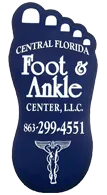Ganglions
YOUR PODIATRIC PHYSICIAN TALKS ABOUT GANGLIONS
What is Ganglions? A ganglion is a fluid-filled swelling of the lining of a joint or tendon. Although ganglions can form on any part of the foot, they most often appear on the ankle of top of the foot. Ganglions tend to change in size and usually grow slowly.
Some Causes
Repeated irritation can weaken the lining of a joint or tendon and lead to ganglions.
People who wear boots are more vulnerable to ganglions, as this type of footwear puts stress on the foot and ankle. Bone spurs (bony outgrowths) may also cause ganglions by irritation the joints and tendons.
Symptoms
Ganglions often form with no symptoms. But if the ganglion puts pressure on the nerves in the overlying skin, it can cause tingling, numbness, or pain. Ganglions sometimes swell and their size can change with different activates or a change in weather.
How Are They Diagnosed?
Because ganglions are sometimes mistaken for tumors, it's important to have a complete examination and, possibly, tests to confirm the diagnosis.
Medical History
Your podiatrist asks you question such as how long you've had the ganglion, what kind of symptoms you're feeling, if it has changed in size, or if it's size varies according to your activities.
Physical Exam
During your evaluation, your podiatrist may do a translumination exam, shinning a light through the swelling (usually, you can see through a ganglion, but not through a tumor). When your foot is palpated (pressed), a ganglion feels spongy and the fluid moves from side to side.
Tests
If a bone spur is suspected, x-rays may be needed. Fluid removal (needle aspiration) may be done to help determine the degree of swelling and to decrease pain. To confirm a ganglion, magnetic resonance imaging (MRI) may be done, which reveals images of soft tissue and done. Sometimes, special dyes may be injected into the area to show the outline of a ganglion.
How Are Ganglions Treated?
Ganglions are often difficult to treat without surgery-- but nonsurgical methods may be helpful in relieving some of your symptoms.
Nonsurgical Care
- Pads placed around the ganglion can ease pressure and friction.
- Fluid removal may also relieve symptoms, through ganglions may recur.
- Limitation movements or activities that increase pain may bring relief.
- Icing the ganglion for 15-20 minutes may temporarily relieve inflammation and pain.
- If your inflammation is severe, your podiatrist may treat your symptoms with medication.
